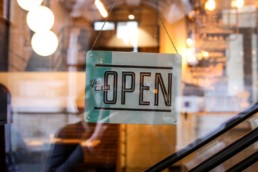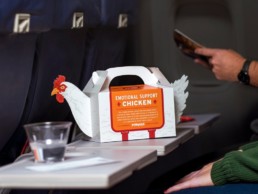O2O: Bridging the Gap for the Online-to-Offline Consumer Experience
marketingstrategy
As e-commerce becomes more prevalent year-over-year, online and brick & mortar stores (and even DTCs) are scrambling for consumer attention. At the same time, demands for extraordinary experiences grow from both a digital and a physical retail point of view, but from the consumer perspective and certainly from the brand perspective, there is a struggle between the two worlds when it comes to how they work together.
Enter O2O: Online-to-Offline commerce.
O2O is a business strategy designed to bring online customers to brick & mortar locations, as well as create a seamless digital experience before, during, and after their purchases.
Many factors conspired together to create the need for an O2O strategy, but the most important one is that consumers see desktop-mobile-physical shopping and buying as fluid while many companies and brands distinguish them, set attribution targets for each, train and incentivize employees in silos, and make it hard to share data between digital and physical interactions.
The positive spin and the core of O2O strategy? More touchpoints and more opportunities.
Gone are the days of warehouse shelving and big brown boxes stuffed with peanuts and bubble wrap–consumers are driving expectations higher while asking for eco alternatives and at-my-fingertips convenience all at the same time and from every step of the buyer journey.
According to a December 2018 Shopify article, “Every brand wants to capture its market in totality, to reach customers new and old through mediums on-site and off. Today if your company doesn’t have a multi-channel marketing strategy…good luck keeping up.”
This means providing online, brick & mortar, catalog, mobile, and social options in unison. The article also explains that, on average, multi-channel marketing and selling increases revenue by 38%, 120%, 190% with each additional channel respectively.
This kind of growth is considerable and needed in today’s retail climate. However, one area that still gets left unnoticed is how one bridges the online/on-site gap.
Typically, businesses offer consumers choices: they can buy online and have it delivered, or they can go to a store and make a purchase. But what about those who research online and then go to the store to make their purchase? What happens when they order a product and want to pick it up in-store? More so, how do businesses convince consumers to buy online and pick up in store to not only create a more well-rounded shopping experience but to also create their own unique experience and brand-in-hand experience? What is the incentive for consumers to do both?
The answer lies in the conversation that already surrounds O2O. The known benefits of O2O commerce allow businesses to treat online and offline channels as complementary rather than competitive.
- Rapid in-Store pickup of products purchased online
- Online purchase of products while at a physical store (quantity, size, color variations and more vs a lost sale)
- Physical store returns & exchanges for online purchases
- Additional incentives and well-rounded shopping experiences when customers combine online and offline purchases
- A combination of online tracking to offer personalized shopping experiences while consumers are actively shopping
- New opportunities for trial and loyalty program engagement.
Research shows that many customers still want to have shopping experiences that allow them to have tangible interactions with the products they want to buy, but they don’t want to give up their technology.
In a recent study by CBRE Group, discovered that even younger people prefer an in-store, tangible shopping experience. The survey showed that 70% of millennials prefer shopping in stores, even though they spend an average of 7.5 hours a day online. This is one of the top reasons some 22+ beloved “DTC Only” brands have all opened physical spaces beyond temporary pop-ups (including Bonobos, Glossier, Aday, Everlane…and more)
However, despite the need for online and on-site stores to be interchangeable, there is still work to be done, but we are seeing considerable progress with how the two are working together in more efficient, collaborative ways. Nordstrom, Warby Parker, and Allbirds are all examples of companies who have their finger on the pulse of O2O strategy, and they see returns on investment for their efforts. We believe this competitive advantage will only increase over time.
The bottom line is that the buzz around O2O is getting louder, which means e-commerce, retail, packaging, marketing strategies, and on-site touchpoints are essential to address holistically–they can no longer be separated or standalone.
To learn more about how Vivabox can help connect your offline and online experiences using trial & loyalty kits, white label customer care, and more reach out any time! info@vivaboxsolutions.com
Looking for a solution? We can help.
Headquarters
9211 Corporate Blvd Ste 110
Rockville MD 20850
Satellite Offices
Dallas, TX
Paris, France
San Francisco, CA
Scottsdale, AZ
info@vivaboxsolutions.com
Phone
800-529-1988
Minimum Order Quantities:
RPET Totes: 3,000
Kraft Shoppers: 5,000
Rigid Boxes: 3,000
Folding Cartons: 5,000
It’s Not Medieval; It’s a Renaissance: Why Retail Isn’t Dead
marketingstrategy
We hear it quite a bit these days: online shopping is killing brick and mortar retail. It’s only a matter of time before it runs traditional stores out of business. Malls are drying up, stores we all grew up with are going out of business, and comparison shopping with the swipe of a finger on a digital screen has customers leaving stores without a purchase because they can buy it online, or somewhere else, for less.
As of the last quarter of 2018, e-commerce sales account for just 9.9% of overall retail sales in the US. That means 90.1% of all purchases are still being made in physical stores. The increase in online sales is growing, which creates a digital disruption of brick-and-mortar, but retail is far from dead and buried. To remain competitive in today’s mobile-fueled marketplace, retailers need to pay closer attention to market demand and conform their stores to changing consumer habits. Better yet, set a new standard for shopping and buying.
Despite the gloomy forecasts of retail, consumers still enjoy the instant gratification that comes from buying products in person instead of waiting for delivery (even if it’s only a day or a few hours). They enjoy the experience of shopping–not necessarily the simple act of purchasing. Those are two different emotions and should be catered to separately. They love a clever, or attractive, package that they can hold and inspect which might offer a spark of wonder and intrigue — all before they buy. They love a curated box that speaks to their inner “foodie” or “self-care” opportunity.
They want to explore new products and brands to break out of the same-old experiences they are used to. They want products (and services) that make them feel catered to and special. Even those on tight budgets love a little luxury that comes with experiential, adventurous shopping. They want beautiful environments with lovely smells, soft items to “pet,” and products with a wow factor (for themselves and others).
Moreover, the products consumers buy from retail stores are not just items they may need or want, but these items are also like souvenirs they bring home from the stores they frequent. I have been in eye-catching stores with beautiful set-ups and soft lighting, and I found myself wanting to buy something, even if it is a small item because I wanted to take a piece of that experience home with me.
As long as retailers are differentiating themselves on unique products and more remarkable shopping experiences (including exceptional customer service, BOPIS services, vibrant environments, and corresponding digital channels that pair well with their stores), it is easy to recognize that physical retail isn’t dead at all. The atmosphere is quite robust for stores that listen to consumer demands and think like consumers, not like legacy retailers.
Stop into Hudson Yards in NYC for a view into experimental retail spaces — touchable art, IG-friendly stores (Atelier Cologne), food halls and unique food stops (David Chang’s Fuku), landmark experiences (The Vessel), boutique coffee (Blue Bottle), stores that offer self- or assisted-checkout (Stance, Dirty Lemon), alongside a family-friendly sweets-and-games experience from Snark Park — all as ways to bring stickiness (borrowing from digital here) to an environment. And it’s working. Try not to feel wowed when you walk in.
Apocalyptic retail forecasts are only accurate for companies that continue down the “one-size-fits-all” branding and dull store experiences where products are stacked on shelves to get lost in the clutter. There is significant opportunity to take advantage of the 50% year-over-year growth that still exists in physical retail–it just has to be different than what has been done in the past.
Learn more about how Vivabox can curate exploratory, experiential packaging for your products to meet current consumer demands and offer your company better options and fresh SKUs for growth in the changing retail landscape.
Looking for a solution? We can help.
Headquarters
9211 Corporate Blvd Ste 110
Rockville MD 20850
Satellite Offices
Dallas, TX
Paris, France
San Francisco, CA
Scottsdale, AZ
info@vivaboxsolutions.com
Phone
800-529-1988
Minimum Order Quantities:
RPET Totes: 3,000
Kraft Shoppers: 5,000
Rigid Boxes: 3,000
Folding Cartons: 5,000
Know Your Customer: Developing Personas for Packaging Strategy
marketingstrategy
The key to a successful marketing or branding campaign starts with understanding your target audience, and, a well-defined audience begins with developing buyer personas. In the age of IG and e-commerce, your primary and secondary packaging design should most definitely be part of your CX process and strategy.
A buyer persona is defined as a well-developed character created from customer trends and demands. Most companies attract more than one group of people, so they find it beneficial to develop three-dimensional personalities with names, ages, occupations, certain social statuses, education levels, aesthetic principles, family size, buying trends, and more. Brands interact with people, not cardboard cutouts, so developing these personas are helpful to create a range of insights.
Simply put, developing personas is important, and it is incredible what insights surface when companies take the time to get to know them.
Personas and Packaging
When thinking about brand development and the multiple personas you must nurture, packaging becomes a primary touchpoint. Outside of the actual product, the package is the most tangible branding tool a business has, and these personalities can have a significant impact on your design strategy.
For example, if you’re targeting an older persona, you may want to work with more traditional packaging or play with nostalgic designs that tug at their heartstrings or work with packaging that can be repurposed. You also want to assess your font size and contrast and including smart and obvious ways to open the package for hands that have lost some dexterity.
If you’re going to attract a millennial persona, you may want to develop a more sustainable solution that works with contemporary or forward-looking design and trends. And be sure it has an element of IG-bait.
Packaging the same product in different ways can be a great way to embrace all of your personas without exclusion.
The Power of Personas
Once your business has developed well-rounded personas, what can you do with them? You can do anything! Hopefully, you use them to make every brand decision. Considering that it is the consumer that creates demand, it is essential that all marketing and branding strategies keep all personas in the forefront of every decision.
Consulting personas for insights into what your audience will identify with and what will capture their interest is essential to determining the shape, font, color, textures, and materials you use in your packaging design.
As you develop your packaging for your personas, don’t forget to measure your successes and room for improvement. Analyzing past data and current customer responses is a great way to test if your packaging ideas are meeting consumer standards and how they may be changing. Don’t let your personas get stagnant. They should be an ever-changing point of reference to keep your brand, and packaging, moving forward.
Looking for a solution? We can help.
Headquarters
9211 Corporate Blvd Ste 110
Rockville MD 20850
Satellite Offices
Dallas, TX
Paris, France
San Francisco, CA
Scottsdale, AZ
info@vivaboxsolutions.com
Phone
800-529-1988
Minimum Order Quantities:
RPET Totes: 3,000
Kraft Shoppers: 5,000
Rigid Boxes: 3,000
Folding Cartons: 5,000





